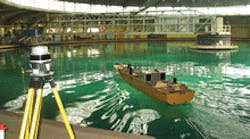A GPS device based on lasers instead of satellite transmissions lets manufacturers double-check the dimensions and positioning of big parts and assemblies. Laser-based metrology isn’t new. Manufacturers have been using laser trackers and interferometers for years. However, they may be limited to the line-of-sight of a single laser, or may require unique and complex setups for each new part.
In contrast, laser-guided indoor GPS (iGPS) from Nikon Metrology, Leuven, Belgium, relies on infrared-laser transmitters, each broadcasting three signals, and sensors connected to software that renders a 3D image with x, y, and z coordinates accurate to within 200 μm or less. The device can handle an unlimited number of transmitters, permitting flexibility and accurate operation in areas larger than 1,000 sq ft.
Nikon-designed software maps part surface and volume onto a preloaded geometric model. The map lets engineers catalog location, length, shape, and orientation of scratches, gouges, bubbles, holes, and cracks. Engineers can also continuously monitor a variety of parts, jigs, and other items in the work envelope, which precisely join large assemblies.
Nikon recently upgraded the device, tapping Lincoln Laser, Phoenix, to redesign the transmitters.
“Lincoln provided insight on the optics and lasers,” says Jarrad Morden, general manager of North American Operations for Nikon Metrology. “And the company’s approach to manufacturing the assemblies made the overall design more cost effective.”
The iGPS sends out encoded laser beams in a 360° horizontal pattern. The previous limit was 270°. Transmitter spin-up to the operational speed (3,000 rpm) is also faster and has less vibration.
“We built in rotary transformers with magnetic couplings that would not affect the spinning velocities or put drag on the unit,” says Sean Coleman, Lincoln Laser design engineer.
Each transmitter continually generates three signals: two rotating fanned IR beams and an omnidirectional IR LED strobe. The fanned beams are tilted ±30° with respect to the rotation axis to permit ±60° vertical coverage. The strobe fires whenever the transmitter head reaches a predetermined angular position in its rotation.
The strobe establishes the transmitter’s identity and location, a necessity because each transmitter in the constellation rotates at a slightly different speed. Receivers on objects in the work envelope pick up the pulses about 50 times/sec.
Amplifiers convert analog signals to digital pulses. Then, an algorithm in the Nikon software determines the relative position and orientation of each transmitter and establishes an index that becomes the basis for azimuth angle measurements. The fanned laser beams provide elevation-angle data. The software maps receiver positions on the shop floor by triangulating elevation and azimuth data detected by the receivers.
To inspect a part, engineers load its geometric model into the software. The software orients the model to the transmitter-receiver device’s field coordinates with the help of a sensor probe placed on a predetermined spot on the part. In addition, the software superimposes any manual measurement data on the geometric model.
About the Author
Jessica Shapiro
Jessica serves as Associate Editor - 3 years service, M.S. Mechanical Engineering, Drexel University.
Work experience: Materials engineer, The Boeing Company; Primary editor for mechanical and fastening & joining.
